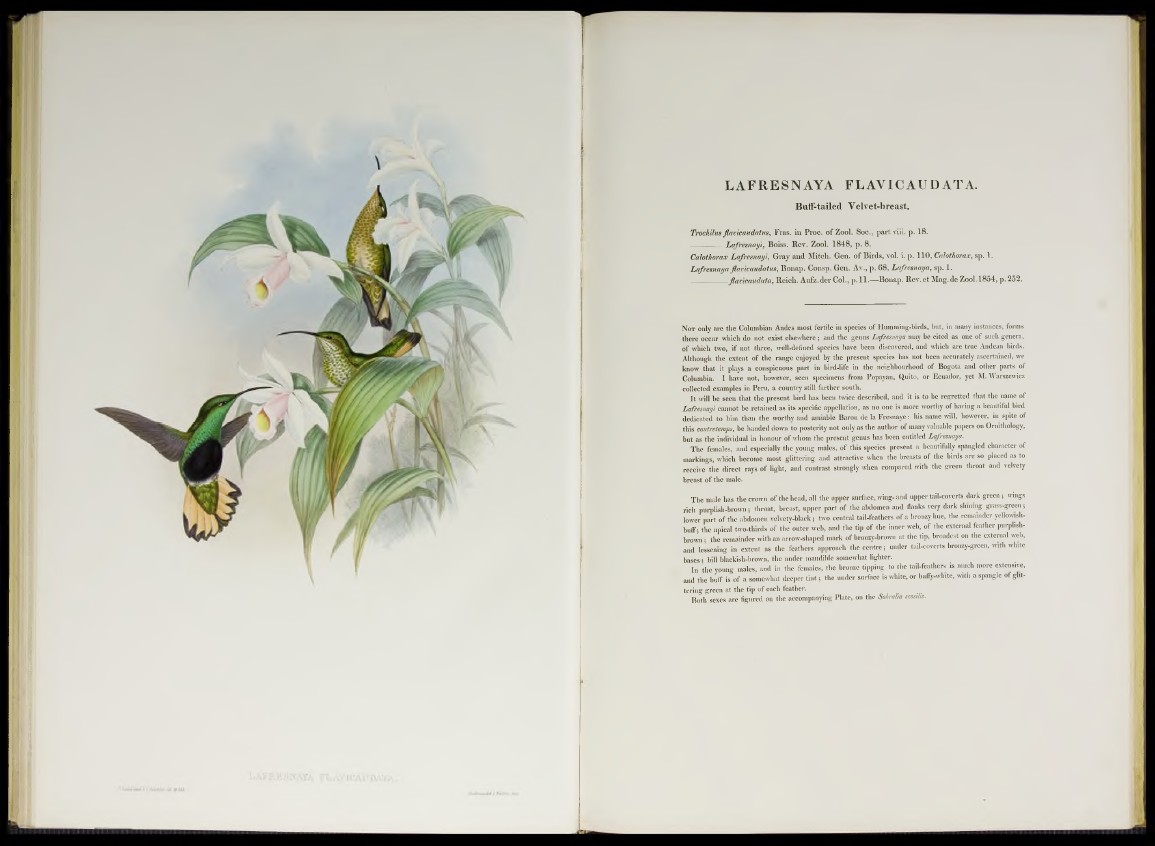
LAFRESNAYA FLAYICAUDATA.
Buff-tailed Yelvet-breast.
Trochilus flavicaudatus, Fras. in Proc. of Zool. Soc., part viii. p. 18.
------------Lq/remayi, Boiss. Rev. Zool. 1848, p. 8.
Calothoracc Lafremayi, Gray and Mitch. Gen. of Birds, vol. i. p. 110, Calothorax, sp. Sj
Lafresnaya flavicaudatus, Bonap. Consp. Gen. Av., p. 68, Lafremaya, sp. DL.
_________ flamcaudata, Reich. Aufz. der Col., p. 11.—Bonap. Rev. et Mag. de Zool.1854, p. 252.
N ot only are the Columbian Andes most fertile in species of Humming-birds, but, in many instances, forms
there occur which do not exist elsewhere; and the genus Lafresnaya may be cited as one of such genera,
of which two, if not three, well-defined species have been discovered, and which are true Andean birds.
Although the extent of the range enjoyed by the present species has not been accurately ascertained, we
know that it plays a conspicuous part in bird-life in the neighbourhood of Bogota and other parts of
Columbia. I have not, however, seen specimens from Popayan, Quito, or Ecuador, yet M. Warszewicz
collected examples in Peru, a country still farther south.
It will be seen that the present bird has been twice described, and it is to be regretted that the name of
Lafresnayi cannot be retained as its specific appellation, as no one is more worthy of having a beautiful bird
dedicated to him than the worthy and amiable Baron de la Fresnaye: his name will, however, in spite of
this contretemps, be handed down to posterity not only as the author of many valuable papers on Ornithology,
but as the individual in honour of whom the present genus has been entitled Lafresnaya.
The females, and especially the young males, of this species present a beautifully spangled character of
markings, which become most glittering and attractive when the breasts of the birds are so placed as to
receive the direct rays of light, and contrast strongly when compared with the green throat and velvety
breast of the male.
The male has the crown of the head, all the upper surface, wing- and upper tail-coverts dark green ; wings
rich purplish-brown; throat, breast, upper part of the abdomen and flanks very dark shinmg grass-green;
lower part of the abdomen velvety-black j two central tail-feathers of a bronzy hue, the remamder yellowish-
buff; the apical two-thirds of the outer web. and the tip of the inner web, of the external feather purplish-
brown • the remamder with an arrow-shaped mark of bronzy-brown at the tip, broadest on the external web,
and lessening in extent as the feathers approach the centre; under tail-coverts bronzy-green, with white
bases • bill blackish-brown, the under mandible somewhat lighter.
In the young males, and in the females, the bronze tipping to the tail-feathers is much more extensive,
and the buff is of a somewhat deeper tint; the under surface is white, or buffy-white, with a spangle of glittering
green at the tip of each feather.
Both sexes are figured on the accompanying Plate, on the Sobralia sessilis.